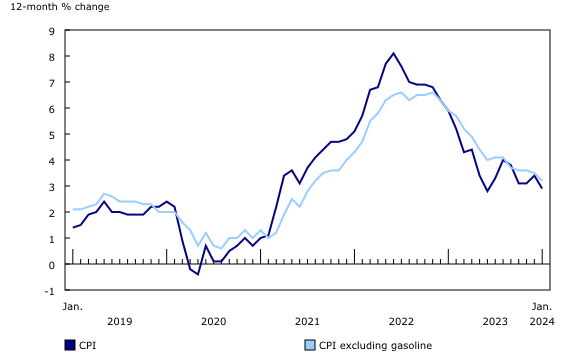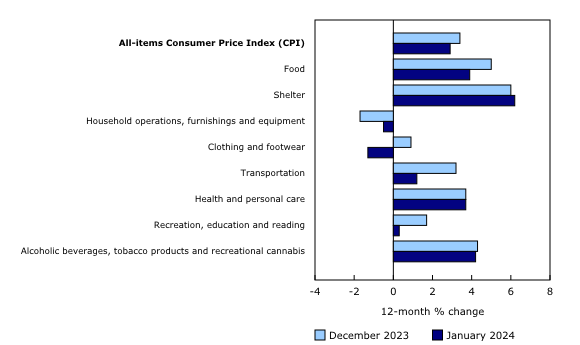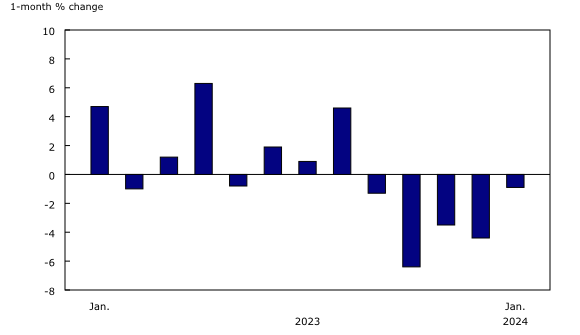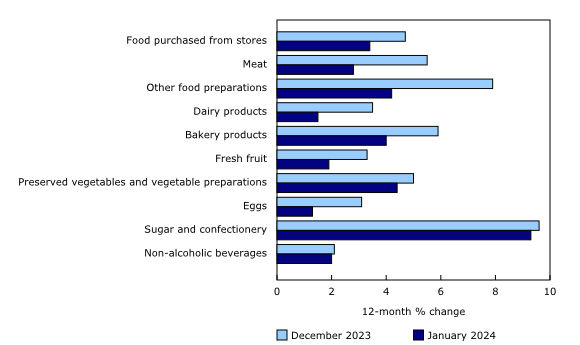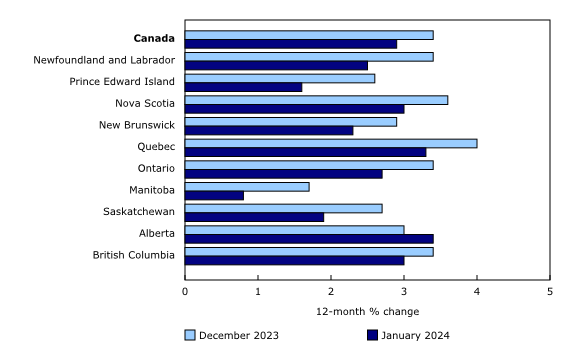Consumer Price Index, January 2024
Released: 2024-02-20
The Consumer Price Index (CPI) rose 2.9% on a year-over-year basis in January, following a 3.4% gain in December. The largest contributor to headline deceleration was lower year-over-year prices for gasoline in January (-4.0%) compared with December (+1.4%). Excluding gasoline, headline CPI slowed to 3.2% year over year in January, down from the 3.5% growth in December.
Price growth for food purchased from stores slowed year over year in January (+3.4%) compared with December (+4.7%), putting downward pressure on the all-items CPI. Lower prices for airfares and travel tours also contributed to the headline deceleration.
On a monthly basis, the CPI was unchanged in January, following a 0.3% decline in December. On a seasonally adjusted monthly basis, the CPI fell 0.1% in January, the first decline since May 2020.
Gasoline prices decline
Year over year, gasoline prices fell 4.0% in January following a 1.4% increase in December, largely due to a base-year effect. In January 2023, prices at the pump increased amid refinery closures in the southwestern United States following Winter Storm Elliott.
On a monthly basis, prices for gasoline fell in January 2024 (-0.9%) for the fifth consecutive month. Lower gas prices in Manitoba (-14.1%) contributed to the national decline, following a temporary suspension of the provincial gas tax.
Grocery prices increase at a slower pace
While grocery prices remained elevated, their growth slowed year over year in January (+3.4%) compared with December (+4.7%).
The deceleration of grocery prices was broad-based, with products such as meat (+2.8%), other food preparations (+4.2%), dairy products (+1.5%), bakery products (+4.0%) and fresh fruit (+1.9%) contributing to the slower year-over-year price growth in January. Other food items, such as soup (-2.1%), bacon (-8.4%) and shrimps and prawns (-3.4%) had year-over-year price declines in January.
Consumers pay less for airfares
Prices for airfares declined in January (-14.3%) compared with December (-9.7%) on a year-over-year basis.
On a monthly basis, prices fell in January (-23.7%) compared with December (+31.1%). Airfares typically decline in January as heightened holiday demand subsides.
Explore the Consumer Price Index tools
Check out Statistics Canada's new Food Price Data Hub, which features a variety of food price related statistics, articles and tools.
Check out the Personal Inflation Calculator. This interactive calculator allows you to enter dollar amounts in the common expense categories to produce a personalized inflation rate, which you can compare to the official measure of inflation for the average Canadian household—the CPI.
Browse the Consumer Price Index Data Visualization Tool to access current (Latest Snapshot of the CPI) and historical (Price trends: 1914 to today) CPI data in a customizable visual format.
Canadians pay more for cellular services in January compared with December
On a year-over-year basis, prices for cellular services fell 16.4% in January following a 26.8% decline in December.
On a monthly basis, prices rose 6.7% in January compared with December, as prices returned to earlier levels following promotions offered in November and December.
Regional highlights
Year over year, prices rose at a slower pace in January compared with December in nine provinces.
Alberta was the only province with faster price growth, partly due to higher electricity prices in January (+119.9%) compared with December (+22.9%) as the result of a base-year effect. The large monthly decline in January 2023, when many Albertan households received rebates on their electricity bills, is no longer affecting the year-over-year movement.
In Saskatchewan, the collection of the carbon levy ceased in January 2024, contributing to the province's year-over-year price decline of natural gas (-26.6%).
Did you know we have a mobile app?
Get timely access to data right at your fingertips by downloading the StatsCAN app, available for free on the App Store and on Google Play.
Note to readers
Visit the Consumer Price Index portal to find all Consumer Price Index (CPI) data, publications, interactive tools and announcements highlighting new products and upcoming changes to the CPI in one convenient location.
Change to the core inflation measures data
With this release, the CPI-trim and CPI-median year-over-year change figures will be calculated based on index values rounded to one decimal place.
Previously, the year-over-year change figures of these two measures of core inflation were calculated based on full precision (unrounded) index values. In February 2023, Statistics Canada began publishing index-level data series for the CPI-trim and CPI-median, which are rounded to one decimal place, as all indexes in the CPI are published at this level of precision. Therefore, year-over-year changes in these core inflation measures calculated using the latter will not necessarily align with the published year-over-year change figures due to rounding differences.
To eliminate this incoherence, the year-over-year change figures for CPI-trim and CPI-median are now calculated based on index values rounded to one decimal place. As a result of this change, the historical year-over-year change figures for CPI-trim and CPI-median will be revised back to January 1990. These revisions will not exceed +/- 0.1 percentage points.
This change has no impact on the All-items CPI, the seasonally adjusted All-items CPI or the CPI-common.
Canadian Consumer Price Index Enhancement Timeline
The Canadian Consumer Price Index Enhancement Timeline is now available. This interactive timeline of the modernization of the CPI (and related programs) includes dates, links, and a summary of key developments for changes to data sources and methodologies, basket updates, new products and other enhancements.
Real-time data tables
Real-time data table 18-10-0259-01 will be updated on March 4. For more information, consult the document, "Real-time data tables."
Next release
The Consumer Price Index for February will be released on March 19.
Products
The "Consumer Price Index Data Visualization Tool" is available on the Statistics Canada website.
More information on the concepts and use of the Consumer Price Index (CPI) is available in The Canadian Consumer Price Index Reference Paper (62-553-X).
For information on the history of the CPI in Canada, consult the publication Exploring the first century of Canada's Consumer Price Index (62-604-X).
Two videos, "An Overview of Canada's Consumer Price Index (CPI)" and "The Consumer Price Index (CPI) and Your Experience of Price Change," are available on Statistics Canada's YouTube channel.
Find out answers to the most common questions posed about the CPI in the context of the COVID-19 pandemic and beyond.
Contact information
For more information, or to enquire about the concepts, methods or data quality of this release, contact us (toll-free 1-800-263-1136; 514-283-8300; infostats@statcan.gc.ca) or Media Relations (statcan.mediahotline-ligneinfomedias.statcan@statcan.gc.ca).
- Date modified:


